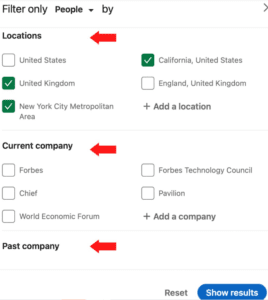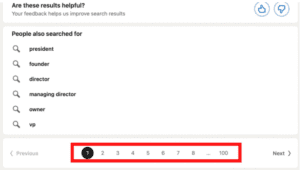
To make your search more targeted and effective, you can type a specific job title. For example, typing manager in human resources is more effective than just manager if you’re in human resources and looking for your next manager.

Make sure you select “people“ so that you don’t get any irrelevant search results. Even though many profiles will pop up, you won’t have to weed through as many profiles if you can be even more specific about exactly which title you want.

After connecting with your first-degree connections (people you know personally), it’s time to move on to your second-degree connections. To do this, select the “2nd connections” option on LinkedIn. Depending on the size of your network, you may find it more challenging to identify people who aren’t already in your network. It’s important to remember that these second-degree connections may not know you as well, or at all, so you may receive fewer positive responses to your connection requests. If this happens, try asking for an introduction from one of your mutual connections or send a personalized message explaining your reason for wanting to connect.

Are you looking to connect with professionals in your area on LinkedIn? One way to do this is by using the location filter in the search bar. Simply specify your location, and you will get search results from people who are located near you. This can be especially useful if you’re looking to expand your network and potentially meet with the people you want to connect with in person.


There will be several pages of professionals that you can scroll through depending on the keywords or filters you choose. Make sure to go through each of them, so you don’t miss any interesting connections.

When you’re ready to send out requests, you can find a “Connect” button beside each person’s name. All you have to do is click. But never connect without…looking at step 6

It’s important to take the time to review their LinkedIn activity in order to learn more about their interests and preferences. By checking out their activity, you can see what they post about and engage with, which can give you valuable insights that you can use to tailor your message and make it more personalized and effective.
In addition, using someone’s name can tap into the psychological phenomenon known as the name letter effect, which refers to the positive bias that people have towards things that are associated with their own name, including the sound and appearance of their name.
By using their name when reaching out and taking the time to review their LinkedIn activity, you can create a more positive and personalized connection and potentially improve the effectiveness of your request.

● Send follow-up messages and CTAs when your LinkedIn invitation gets accepted.
Sending a LinkedIn invitation request is the first step in building a professional relationship. It’s important to follow up and consistently communicate with your new connections in order to build rapport and establish a mutually beneficial relationship.
After accepting your invitation, be sure to thank them for accepting or express your appreciation for their time. If you’ve had a chance to chat with them, send them a quick message thanking them for their time and letting them know that you enjoyed getting to know them better. Here are some examples of LinkedIn message templates that you can use:
Remember to also include a call-to-action (CTA) in your follow-up messages to encourage further engagement and to continue building the relationship. Some examples of CTAs that you can use include: asking for recommendations for LinkedIn groups or events to join, asking for advice or tips, asking for advice on how to get involved or get noticed at their company, or asking about job openings or companies that are hiring in your industry.
● Withdraw an unanswered LinkedIn invitation request
If you’ve sent connection requests to people on LinkedIn and haven’t received a response, it’s okay to withdraw requests. This demonstrates to LinkedIn that you are selective in your connections and have carefully screened those you reach out to.
However, it is important to keep track of the invitations you withdraw, as you will not be able to send a new connection request to the same individual for 3 weeks. Additionally, LinkedIn may notice if you are trying to connect with people who do not know you and penalize you by lowering your LinkedIn Social Selling Index (SSI) score, which is the number LinkedIn uses to measure your performance as a social seller. Therefore, it is generally best to withdraw outstanding requests that have not been accepted after a month.
Connecting with others on LinkedIn is a crucial step in building your professional network and expanding your reach. Luckily, it’s easy to do. This is what we covered:
In just a few minutes, you can send a connection request to anyone on LinkedIn. However, it’s important to note that LinkedIn has strict policies in place regarding the number of connection requests and invitations that can be sent per day. The exact number varies depending on your account type and activity level, but it’s generally recommended to send no more than 20-25 per day.
It’s important to adhere to LinkedIn’s policies regarding the number of connection requests and invitations that can be sent per day, as well as the use of automation. To avoid being banned from the platform, be sure to follow these guidelines.
Regardless of which route you choose, remember that building your network takes time and effort, but the benefits are well worth it.
If you’re looking for professional assistance with growing and maintaining your LinkedIn network, check out MAIA Digital. We specialize in personal profile optimization and B2B marketing on LinkedIn through holistic company page management. As a LinkedIn agency, we work with organizations, high-tech companies, and startups on their marketing, content creation, and recruiting activities on LinkedIn.
If you have any questions or inquiries, don’t hesitate to contact us.